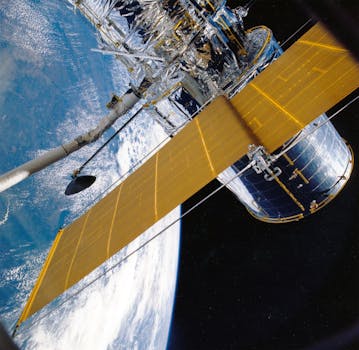The Future is Now: Exploring the Cutting-Edge Innovations in Satellite Telecommunications

Satellite Telecommunications is the focus keyword for this article, and it is an exciting time for this field as it is rapidly evolving with new innovations and technologies emerging every day. The future is now, and it’s essential to explore the cutting-edge advancements in satellite telecommunications to understand their potential impact on our daily lives. Satellite telecommunications play a vital role in connecting people and communities worldwide, providing access to information, communication, and entertainment.
One of the most significant innovations in satellite telecommunications is the development of Low Earth Orbit (LEO) satellites. LEO satellites are designed to operate at lower altitudes, typically between 160 and 2,000 kilometers, which enables them to provide faster and more reliable communication services. Companies like SpaceX, Amazon, and OneWeb are leading the charge in launching constellations of LEO satellites to offer global internet coverage, especially in areas where traditional connectivity is limited or non-existent.
Another area of innovation is High-Throughput Satellites (HTS). HTS technology allows for faster data transfer rates, making it possible to support a wide range of applications, including broadband internet, video streaming, and mobile connectivity. HTS satellites are designed to provide higher capacity and more efficient use of bandwidth, which is critical for meeting the growing demand for data-intensive services.
Advancements in Satellite Technology
In addition to LEO and HTS satellites, there are several other advancements in satellite technology that are worth mentioning. Phased array antennas are being developed to enable satellites to dynamically steer and shape their beams, allowing for more efficient use of bandwidth and improved signal quality. Quantum encryption is another area of research, which promises to provide unbreakable security for satellite communications.
Satellite telecommunications are also being used to support Internet of Things (IoT) applications. With the increasing number of connected devices, satellite communications can provide the necessary connectivity to support IoT applications in remote or hard-to-reach areas. This can include applications such as smart agriculture, environmental monitoring, and industrial automation.
Impact on Daily Life
The innovations in satellite telecommunications are having a significant impact on our daily lives. With the availability of global internet coverage, people in remote or underserved areas can now access information, communication, and entertainment services. This can have a profound impact on education, healthcare, and economic development, especially in developing countries.
Satellite telecommunications are also supporting emergency response and disaster relief efforts. In the event of a natural disaster, satellite communications can provide critical connectivity to support rescue and recovery operations. This can include providing emergency responders with access to vital information, such as maps, weather forecasts, and damage assessments.


